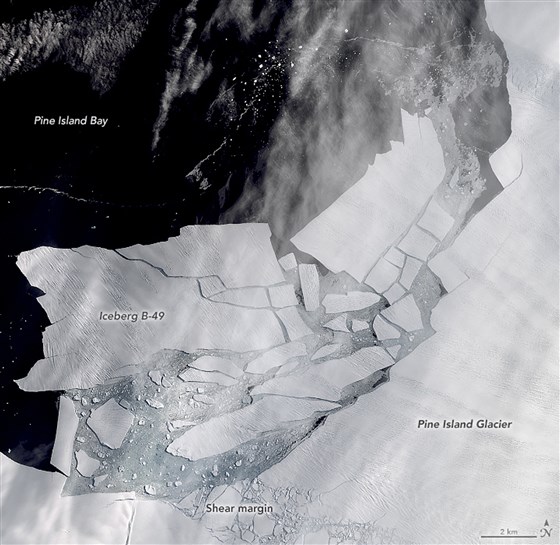Two giant icebergs broke off Antarctica.
Here's what that means for the continent's health.Original article here.
Antarctica’s Pine Island Glacier is one of the most
closely watched pieces of ice on Earth, and scientists
are warning about -signs of climate change. Feb. 19, 2020, 1:58 PM CST
By Tom Metcalfe
Twitter: Tom Metcalfe @globalbabel
Antarctica’s Pine Island Glacier is one of the most closely watched pieces of ice on Earth.For
years, scientists have tracked as chunks of the glacier have broken
off, an awe-inspiring event known as “calving” that happens naturally.
But it’s happening more often at the Pine Island Glacier, also known as
PIG, and it’s got glaciologists worried that climate change is to blame.“The calving events at Pine Island Glacier are coming more frequently than they used to,” said glaciologist Adrian Luckman from Swansea University in the U.K. in an email.Glaciologists
have raised alarm that a massive new iceberg, designated B-49, may be a
result of melting caused by relatively warm water eating away at the
ice that surrounds the frozen continent.B-49
is one of two large icebergs now floating away from Antarctica. It
broke away from PIG last week, while the other, a trillion-ton behemoth
dubbed A-68, broke away from the Larsen C Ice Shelf, on the east coast
of the Antarctic Peninsula, in 2017, scientists say. 
Iceberg B-49 is about twice the size of Washington D.C.
But Iceberg A-68, unlike B-49, is probably not a result of a warming climate, said Luckman and other glaciologists.Iceberg
B-49 covers 40 square miles, while the many smaller icebergs that also
broke free on Feb. 9 cover another 80 square miles.An
international scientific team has just completed its first major field
season on the giant Thwaites Glacier, about 200 miles from Pine Island
Glacier, beside the Amundsen Sea in West Antarctica.They are trying to learn why glaciers in the region are melting.“This is a place where we know the ice shelves are thinning quite fast,” said glaciologist Helen Amanda Fricker from the Scripps Institution of Oceanography in San Diego. “It has been identified as an area that is changing rapidly.”Satellite
photographs show Thwaites Glacier and PIG have started flowing faster
in recent years, while their edges of floating ice have pulled back
toward the land.“The
increased frequency of calving seems to be related to the thinning of
the ice tongue,” Luckman said. “This is probably caused by the
incursion of warmer waters into the area, which may be related to
climate change.”Glaciers
in West Antarctica like the Thwaites and PIG worry scientists because
their melting could eventually expose inland glaciers and even more
ice, causing a drastic rise in sea levels.Some recent scientific models predict that Antarctica’s melting alone could cause sea levels to rise by almost 2 feet by 2100.Iceberg A-68, which covers more than 2,000 square miles, recently left Antarctica’s Weddell Sea, heading for the Southern Ocean.Several
research ships have since tried to study the pristine seabed it covered
for thousands of years, but the floating ice in the Weddell Sea has
been too heavy for them to get there.While
many icebergs break off from the normal processes of Antarctica’s
coastal glaciers flowing into the sea, Luckman said the changes in the
west of Antarctica appear to be caused by a warming climate.“Taken
as a whole, the generalized retreat of ice shelves along the Antarctic
Peninsula, and especially the thinning elsewhere such as at Thwaites
Glacier, shows clearly that climate change is causing accelerating mass
loss from Antarctica to the oceans,” he said. Tom Metcalfe
Tom Metcalfe writes about science and space for NBC News.Back to News



